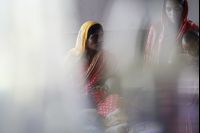Thursday, April 18, 2024
News and Views from the Global South
Rewriting 195 Million Stories of Childhood Malnutrition
Hannah Rubenstein
- In a vast field, a sinewy, dark-skinned man bends at the waist, slicing stalks of wheat with a small machete. In a village, a mother gently places her infant son, slung in a piece of blue fabric, onto a vegetable scale housed in a makeshift clinic.
These images are intercut with startling statistics: 48 percent of Bengali children under five are malnourished. One-third of the country’s child morality is a direct result of severe malnourishment. Malnourished mothers give birth to malnourished children. The cycle continues.
The short documentary, entitled “Bangladesh: Terrifying Normalcy”, is the work of award-winning photojournalist Ron Haviv. Haviv spent two weeks on the Bengali island of Bhola documenting severe acute malnutrition (SAM) in mothers and children caused by a combination of food insecurity, rapid climate change and poverty.
“Bangladesh” is one of seven works that comprise the multimedia exhibit “Starved for Attention: The Crisis of Childhood Malnutrition”, on display in Brooklyn’s VII Gallery in DUMBO until Jul. 2.
“Starved for Attention” is presented by Doctors Without Borders/Médecins Sans Frontières (MSF) and the VII Photo Agency, of which Haviv is a co-founder. In addition to Haviv, VII photojournalists Marcus Bleasdale, Jessica Dimmock, Antonin Kratochvil, Franco Pagetti, Stephanie Sinclair, and John Stanmeyer travelled to malnutrition “hotspots” worldwide to document the crisis.
Each documentary work presents a glimpse into the lives of those affected by malnutrition, from displaced persons camps in the Democratic Republic of Congo to fish markets in Burkina Faso.
The exhibit is one element of a campaign to combat childhood malnutrition, a global phenomenon that affects over 195 million children under the age of five, 90 percent of whom live in sub-Saharan Africa and South Asia.
MSF’s campaign urges the public to sign an online petition supporting the end of what the organisation terms “substandard” food aid donated to impoverished countries through international donors and humanitarian contributions. The majority of the donations are cereal-based fortified flours that do not meet basic nutritional standards for infants and young children, according to MSF nutrition expert Dr. Susan Shepherd.
“Much more attention is paid to the food of cattle and pets,” Shepherd told more than 500 attendees of a panel discussion that accompanied the exhibit launch on Wednesday. She urged the international community to “give the children what they need, not what is left over. Treat the young children of developing countries the same way you would treat your own children.”
Panel member Biraj Patnaik, principal adviser to the Commissioners of the Supreme Court in India’s Right to Food Case, explained that the public needs to increase pressure on governments in order to affect change. Malnutrition continues to be passed down from generation to generation. Without public outcry, the cycle will continue.
“Children everywhere are children. They all need the same kind of food,” he said. “We will need to spend more – but it’s an investment for the future.”
Haviv, a member of the discussion panel, explained that recognising the common humanity between children of all nations is the primary goal of the exhibit. Its purpose is to present the subject of malnutrition in a new way.
“Whenever we talk about hunger or malnutrition in terms of images, people go straight to images that they’ve seen, such as those from Niger, Ethiopia, or Somalia,” Haviv told IPS. “And those are certainly important and dramatic images. But they’re usually a very emaciated child near death.”
“There are 195 million stories of people suffering from malnutrition, which is obviously much greater than emergency famines in terms of numbers,” he explained. “These are people that are all around us… I think that it’s something that a lot of people who aren’t hungry don’t think about.”
By replacing cliché images of malnutrition with images that portray the daily experiences of individuals and families worldwide, “Starved for Attention” aims to “put a face on the staggering statistic”, Haviv told IPS.
“It’s an enormous number,” he said. “The individual stories that we tell, from different countries and different people, make it a much more personal, human experience.”
MSF and VII believe that by humanising the issue, the public will be motivated to take action. “The hope is that these voices and photographs will push people to sign the petition,” Haviv said.
There are millions of stories of childhood malnutrition, the campaign asserts; “It’s time to re-write the story.” By visiting the VII Gallery exhibit, watching the documentary videos online, or signing the petition, “Starved for Attention” provides a variety of ways for the public to spread awareness of the global crisis of malnutrition. The hope is to provide children everywhere with the “attention” they deserve.

 Print
Print




